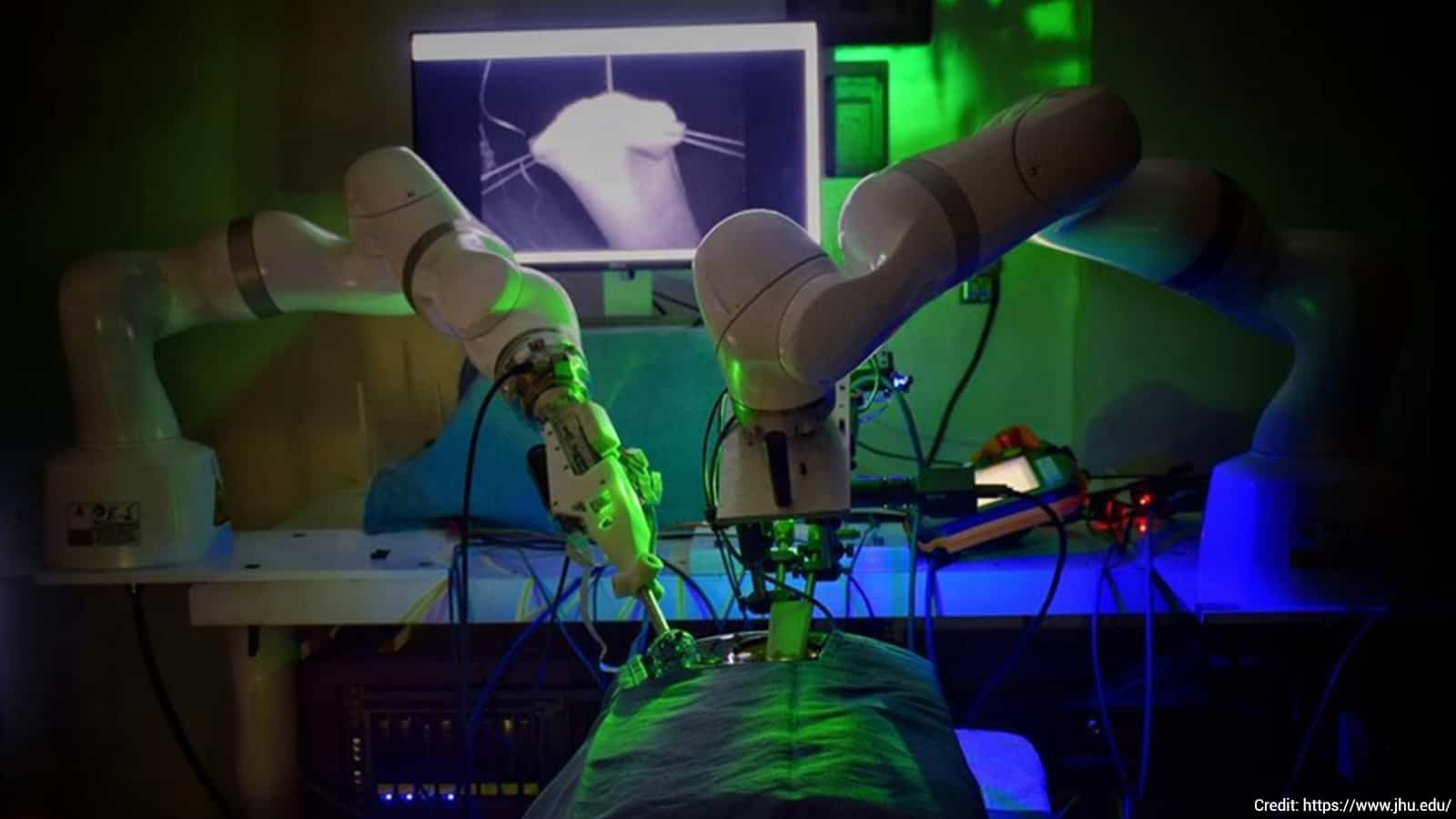A robot surgeon designed by a research team from Johns Hopkins University performed the first successful laparoscopic surgery without human aid. The robot operated on the soft tissue of a pig, excelling at suturing two ends of the intestine. This technology marks a significant step toward completely automated surgery on humans, as it’s one of the most challenging parts of abdominal surgery.
The team explained more about their robot invention in Science Robotics.
“Our findings show that we can automate one of the most intricate and delicate tasks in surgery: the reconnection of two ends of an intestine. The STAR performed the procedure in four animals, and it produced significantly better results than humans performing the same procedure,” said senior author Axel Krieger, an assistant professor of mechanical engineering at Johns Hopkins’ Whiting School of Engineering.
The robot performed a successful laparoscopic surgery known as intestinal anastomosis. This intricate procedure requires top-notch precision and many repetitive movements. Arguably the most challenging step involved in abdominal surgery, connecting two intestinal ends requires consistent perfection from the surgeon. Even a slight misstep could lead to leaks that can cause disastrous side effects for the patient.
The researchers worked with collaborators at the Children’s National Hospital in Washington, D.C., and Jin Kang, a Johns Hopkins professor of electrical and computer engineering. Krieger and his team helped build the robot. A vision-guided system tailored explicitly for suturing soft tissues. It’s perfect for performing operations such as laparoscopic surgery.
The current model is an improvement from an earlier 2016 design that accurately sutured a pig’s intestines. However, the robot had to make a large incision to make the sutures and needed help from humans.
Robot Surgeon Performs a Successful Laparoscopic Surgery
The research team enhanced the STAR with new features for better autonomy this time. They also improved surgical accuracy and consistency by equipping the robot with specific suturing tools and advanced imaging systems. These systems help to improve the accuracy of the surgical field visualizations.
Soft-tissue surgery requires rapid adaptation and reflexes to respond to unexpected challenges. Therefore, it’s one of the hardest surgeries for robots to perform. However, the STAR comes equipped with a control system that can adjust to unpredictability quickly, mimicking a human surgeon.
“What makes the STAR special is that it is the first robotic system to plan, adapt, and execute a surgical plan in soft tissue with minimal human intervention,” Krieger said.
The research team created a structural-light-based 3D endoscope and machine learning-based tracking algorithm to aid STAR’s operation.
“We believe an advanced three-dimensional machine vision system is essential in making intelligent surgical robots smarter and safer,” Kang said.
Since laparoscopic surgeries are becoming more prevalent in the medical field, autonomous robots will play a pivotal role in performing them successfully.
“Robotic anastomosis is one way to ensure that surgical tasks that require high precision and repeatability can be performed with more accuracy and precision in every patient independent of surgeon skill,” Krieger said. “We hypothesize that this will result in a democratized surgical approach to patient care with more predictable and consistent patient outcomes.”
The team from Johns Hopkins also included Hamed Saeidi, Justin D. Opfermann, Michael Kam, Shuwen Wei, and Simon Leonard. Michael H. Hsieh, director of Transitional Urology at Children’s National Hospital, also contributed to the research.
The National Institute of Biomedical Imaging and Bioengineering of the National Institutes of Health helped fund the research.
New Features Ensure STAR Operates with Accuracy
STAR can successfully perform laparoscopic surgery for several reasons. It comes equipped with various autonomous features which allow for greater precision, including:
- ability to start/pause/unpause the tissue-tracking system
- detect breathing motion of tissue
- inform the operator to initiate a replanning step
- detect robot tool failure
- control camera motion and angle
- different modes of suture planning, including uniform and non-uniform spacing
- programming to reduce noise and irregularity
- predict tool collisions with tissue
- synchronize the robot tool with breathing motions of the tissue and under a remote center of motion (RCM)
Of course, the robot still requires a human operator who can select among various suture plans or approve a replanning step. They also monitor the robot throughout the laparoscopic surgery if a repeated stitch becomes necessary. The main goal of autonomous surgery is increasing suture precision and also reducing workload among surgeons. Even though the system still requires manual adjustments for restitching when needed, the robot can autonomously complete over 83% of the laparoscopic surgery.
More Improvements on the Horizon
Compared with the team’s prior robot model designed for laparoscopy, the STAR offers several improvements. The previous robot surgeon had a tissue tracking system that only considered stationary tissue without breathing motions. Also, prefiltering for noise and tool collision prevention was only considered in one of the suture plans.
Furthermore, the robot didn’t have autonomous replanning suggestions, so the operator had to monitor each surgery step. Finally, the design lacked tool failure monitoring and independent camera motion control.
Because of these shortcomings, the robot could only complete about 58% of sutures autonomously without any restitches. So, the STAR offers more benefits and improvements regarding autonomous surgeries. Not only does the robot reduce operator workload, but it also improves patient outcomes. As autonomous surgeries become more normalized, it will help standardize surgical outcomes since they’re not dependent on a surgeon’s experience, prior training, or daily performance.
Because of this, it will enhance the accuracy and consistency of laparoscopic surgery, regarding suture bite-size, spacing, and tension, for example. Ensuring accuracy in these parameters will reduce leaks, which will help improve patient outcomes and reduce surgical complications.
Final Thoughts on Autonomous Robot that Performs Laparoscopic Surgery
The future of laparoscopic surgery may be in the hands of robot surgeons. Johns Hopkins University researchers have created the world’s first robot that performed intestinal surgery without human help. This could revolutionize soft tissue surgeries in the future, reducing the need for human surgeons while improving accuracy. As technology advances, it allows us the freedom to explore our full potential. It’s an exciting time to be alive, indeed.
















 Community
Community

